 Archives for Mosaical Metrology and Mosaistics, AMMM Vol. II, No.
4
Archives for Mosaical Metrology and Mosaistics, AMMM Vol. II, No.
4![]()
![]()
 Archives for Mosaical Metrology and Mosaistics, AMMM Vol. II, No.
4
Archives for Mosaical Metrology and Mosaistics, AMMM Vol. II, No.
4![]()
![]()
| ||||||
my reconstruction of the Tablets of the Law, therefore, an analysis of the various aspects of the original alphabet seemed advisable, last not least the alphabetical order.8) § 4. Wondering why the letters Tet and Taw, in spite of their obvious graphic and phonetic simi- larity, are numbers 9 and 22 in the alphabetical order, and likewise why He and Chet are numbers 5 and 8, is the decisive question, which in spring of 1983 led to my discovery of its two-dimensional structure.9) The first step in this direction was dictated by the prime numbers of the 22 letters of the Hebrew-Phoenician alphabet, which resulted in a column of 11 consecutive letter-pairs, or pairs of odd and even (male and female) numbers, since the firm alphabetical order has always permitted their numerical use.10) The next step was to split –––––––––––––– 8) It is an essential element of every alphabet in the strict sense besides the graphics, phonetics, and semantics of letter-names, but has so far been ignored, see Ed Metzler, The Impact of Israel on Western Philosophy, (Herborn 1993) p. 12 Note 9) Cf. DISCOVERING MOSAISTICS (N. 1) pp. 93–123, especially pp. 101, 102 Note 12, and 103 Note 14. 10) Ibid. pp. 100 Note 8, and 104–105. [7]
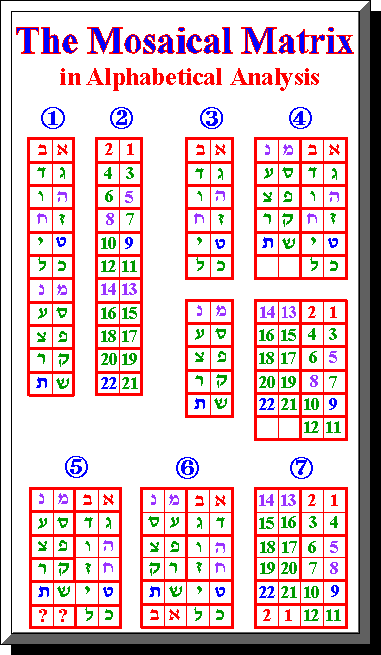 [8]
this oblong column of letter pairs into two nearly equal halves, and to place them next to each other (see nos. 1–4 on the facing diagram), so that the letters Tet and Taw, automatically, stand in the same horizontal four-letter block [blue].11) § 5. Similarly, the letters He and Chet are in the same square four-letter block on top of each other, if its two lines are written in alternating directions (boustrophedon).12) For consistency, all 16 letters above the Tet-Yod-Shin-Taw quaternity have also been arranged boustrophedon in square four-letter blocks, while the two empty spaces at the end are filled with the letters Aleph and Bet, forming a bottomline four-letter block, that reads Kol Aleph-Bet – all of the alphabet (nos. 5–7 on the facing diagram).13) The alphabetical order fits into a tablet of 6 by 4, which coincides with the –––––––––––––– 11) This yields a better distribution of letters on a didactic tablet of 6 by 4, cf. DISCOVERING MOSAISTICS (N. 1) p. 105. 12) Ibid. pp. 106 and 108–109. My didactic table of the alphabet is a 6-day course with 4 one-letter lessons a day, in which the letters Tet-Yod-Shin-Taw are the turning quaternity in the boustrophedon arrangement of four-letter blocks. 13) See diagram ibid. p. 106 Note [9]
biblical measurements of the Ark of the Covenant, being 10 by 6 quarter-cubits.14) There is room in it for 2 tablets of 6 by 4 quarter-cubits each, with  [The printed graphics were replaced by their equivalents from this website] 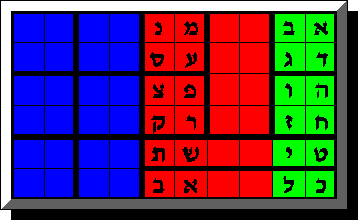 6 by 2 quarter-cubits left empty.15) Half of the alphabet, if painted on the bottom of the Ark, would then be visible at a time.16) –––––––––––––– 14) Exodus 25, 10 = 37, 1: it is 2.5 (= 10 · 0.25) cubits long, and 1.5 (= 6 · 0.25) cubits wide, i. e. 10 by 6 quarter-cubits. 15) Cf. diagrams on pp. 13, 15, 18 no. 2, 19, and 20 infra. 16) See the painted coffin from 12th-dynasty Egypt in the Bible Lands Museum, Jerusalem (Ladders to Heaven, plates vi–vii). By moving the tablets, the empty space [green] shows in the middle or at the bottom, cf. DISCOVERING MOSAISTICS (N. 1) p. [10]
§ 6. Why the Hebrew Bible begins with Bet (Genesis 1, 1), and not with Aleph, led me to view the story of creation as a “beta-text” or secondary composition, and to look for the “alpha-text”, which served as its primary source-model.17) The most central text written by Moses on the two stone Tablets of the Law, and deposited 500 years later in the Holy of Holies of the Temple built by King Solomon in Jerusalem – the Ten Commandments, indeed, begin with the letter Aleph.18) This to me suggested that the second line on the second side of their original inscription might begin with the letter Bet, and in mid July of 1983 resulted in my discovery of the three-dimensional structure of the Ten Commandments (see next page).19) –––––––––––––– 17) Other beta-texts are the New Testament and the Koran as well as the Sefer Yetzirah and the Talmud (tractate Berachot), see Ed Metzler, Western Philosophy (N. 8) p. 14 Note 18) Cf. DISCOVERING MOSAISTICS (N. 1) pp. 22, 69–71, and 117; also p. 17 Note 1 on Genesis (be-Reshit) as secondary. 19) Ibid. pp. 61–91. Even today, the letters Aleph and Bet stand for the front and reverse pages in talmudic quotations. [11]
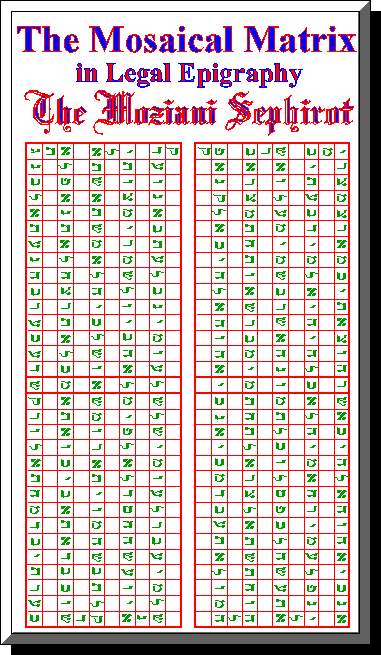 [12]
§ 7. My Tablets of the Law reconstruction sprang from alphabetical text analysis.20) It proved to be more than a mere hypothesis because of  [The printed graphics were replaced by their equivalents from this website]  fitting like a glove into the Ark of the Covenant.21) Folding the 10 lines length- and breadthwise in the middle yields the shape of the tablets.22) Every –––––––––––––– 20) The reconstruction was first published under my pen-name Eliyahu Moziani in the TORAH OF THE ALPHABET (Note 4 supra). The renowned Jerusalem painter and printmaker Yitzhak Greenfield did a limited number of prints from my plate, which he called 21) For its well-known measurements see above Note 22) Cf. DISCOVERING MOSAISTICS (N. 1) pp. 74–78. [13]
vertical line runs 15 letters up, and 15 down, plus one on top connecting front and reverse, and another one between the lines, altogether 10 lines of 32 = 320 letters. Hence each tablet is 10 by 15 letter-units, and one unit thick, so that it consists of 150 cubic letter-units, 15 letter-units matching the 1.5 cubits width of the Ark.23) § 8. By fitting the Tablets of the Law into the Ark of the Covenant we get their absolute measurements in cubits. Since one letter-unit is one tenth of a cubit, known in biblical Hebrew as a Peka, a tablet is one cubit wide, 1.5 cubits high, and one tenth of a cubit thick.24) This leaves room for one hand between the tablets, and between the stones and the wood on either side, adding up to three handbreadths or half a cubit, necessary for handling the tablets.25) However, they only fit into –––––––––––––– 23) Cf. DISCOVERING MOSAISTICS (N. 1) pp. 24) On the Peka, see below p. 17 nos. 3 and 4. 25) The empty space of one handbreadth = 1/6 cubit before, between, and behind the tablets is exactly one Omer, a Mosaical measure of volume, mentioned in the Book of Exodus 16, 33–36: 1/6a · 3/2a · 1/10a = 1/40a³ = 2.22 liters, an ancient Israelite cubit (a = ammah) being 44.63 cm, cf. The Metzler Formula p. 27 infra. [14]
 [The printed graphics were replaced by their equivalents from this website] 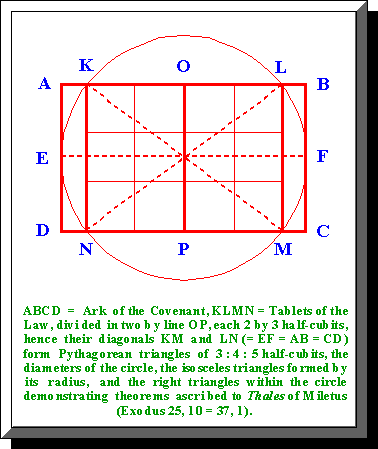 the Ark, if both have perfect right angles. For this reason they use so-called “Pythagorean” numbers (3 : 4 : 5), as the above diagram shows.26) –––––––––––––– 26) See Ed Metzler, Western Philosophy (N. 8) p. 7 Note 7. The duality of the Mosaical Tablets of the Law is due to the “Pythagorean” number of 4 half-cubits, their combined width. [15]
§ 9. By October of 1984, I had realized that the Ark of the Covenant being 2.5 by 1.5 cubits, and the number 2 of the Tablets of the Law, each being one cubit wide, represented the Pythagorean numbers 3, 4, and 5 divided by 2. Next I figured out how, on the basis of this knowledge, a cubit is subdivided into 6 handbreadths or 10 letter-units, as can be seen from the diagrams on the facing page.27) The Star of David results automatically as an auxiliary geometrical construction for drawing the lines of the Ten Commandments.28) Its oldest undisputed example is on a seal from the seventh century B. C. E. found in Sidon and belonging to the Jew Joshua ben Asayahu.29) –––––––––––––– 27) Cf. DISCOVERING MOSAISTICS (N. 1) pp. 24–25, 54–59; TORAH OF THE ALPHABET (N. 4) pp. 2, 6, 8, and 113. 28) Their opening words, I am YaHUH (Yahuweh) thy God, or: I (Moses) SHALL BE your judge and commander-in-chief, explain its symbolic significance, see Ed Metzler, Conflict of Laws in the Israelite Dynasty of Egypt, (Herborn 1991) p. 24 Notes and 39; idem, Western Philosophy (N. 8) Notes 29) His theophoric patronymic bears witness to his Jewish identity, see Gershom Scholem, Kabbalah (Jerusalem 1974) p. 362. [16]
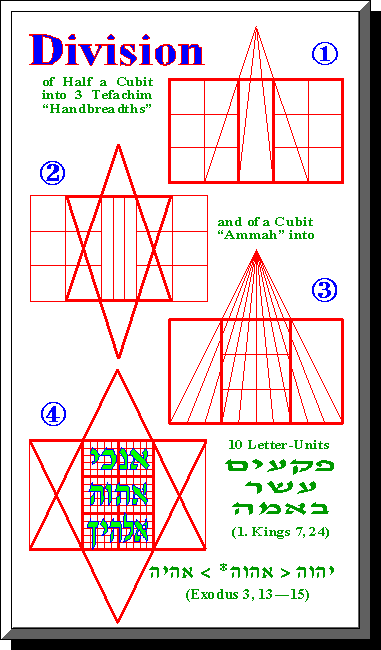 [17]
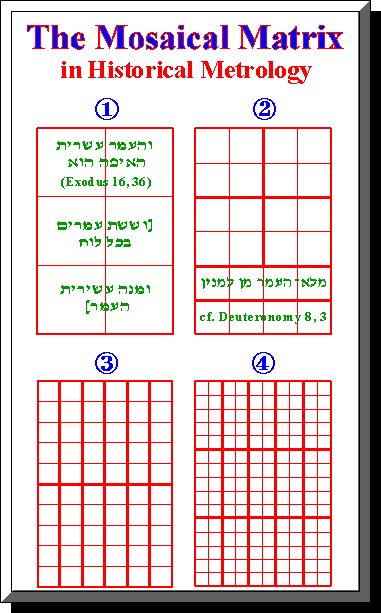 [18]
§ 10. An Omer is 1/6 of a tablet, whether it is divided into 6 squares, horizontal or vertical rows (see diagrams nos. 1–3 on the facing page).30) It is  [The printed graphics were replaced by their equivalents from this website] 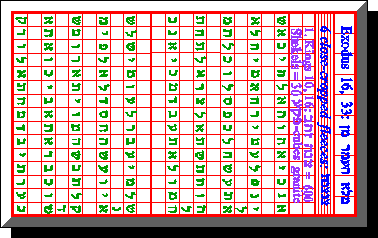 subdivided into 10 Manah “portions”, of which there are 60 in a tablet.31) Since a tablet is also divided into 150 cubic letter-units (diagram no. 4), one Manah equals 2.5 Peka-cubes.32) –––––––––––––– 30) See Ed Metzler, The Mosaical Roots of European Musical Theory, (Herborn 1995) pp. 31) The vertical Omer of diagram no. 3 is divided into 10 portions by halving every second Peka-cube of diagram no. 4. 32) Cf. Notes 12 and 25 supra; idem (N. 30) p. 19 Note 29. [19]
§ 11. A row of 10 granite Manah stones was laid in front of the opening words “I am YaHUH” of the 1st Tablet of the Law (below right).33) One  [The printed graphics were replaced by their equivalents from this website] 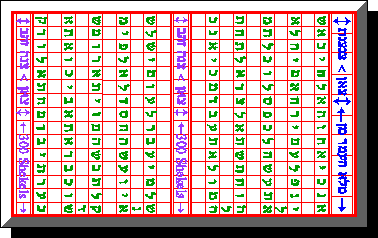 Manah held 222 cm3, and weighed 600 grams = 50 Shekels = 100 Beka.34) Between and behind the tablets, there were twice 15 granite Peka-cubes, all wrapped in close-cropped fleece.35) –––––––––––––– 33) Hence YaHUH is its proper name, cf. Note 34) See Ed Metzler, Musical Theory (N. 30) Note 26. While an average Beka marked Bet-Koph-Ayin is 6.0 gm, would-be Shekels with 35) Ibid. Notes [20]
§ 12. In spring of 1993, I discovered the relevance of Mosaical matrixes (above p. 18, diagrams nos. 3 and 4) for musical theory, when inquiring into the various aspects of Pythagorean philosophy.36) The geometry of the Tablets of the Law (cf. p. 15 supra), the holiness of their Ark (Aron or Merkavah “chariot”, Greek harma, whence “harmony”), of their 10 lines (Sephirot “spheres”), and the vegetarianism of a kosher life-style, all are typical features of Jewish culture, rather than merely personal idiosyncrasies of Pythagoras.37) The same applies to musical theory, where he is credited with the invention of our diatonic scale, and the (intellectual) perception of the Harmony of the Spheres.38) –––––––––––––– 36) See Ed Metzler, Western Philosophy (N. 8) p. 10 Note 37) Bertrand Russell speaks of his “curious psychology”, cf. Ed Metzler, Western Philosophy (N. 8) p. 8 Note 38) On the Jewish blueprints of Pythagorean philosophy, ibid. pp. 6–11; DISCOVERING MOSAISTICS (N. 1) pp. 26–27 Notes 25–27; Musical Theory (N. 30) p. 4 Note 2, p. 14 Note 20. [21]
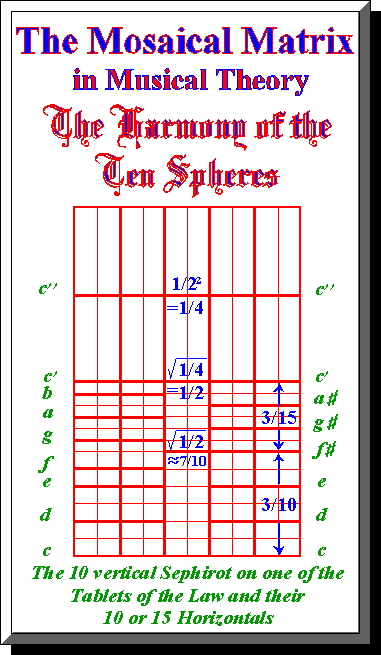 [22]
 § 13. The frequency ratios resulting from Mosaical matrixes show only slight aberrations from the even-tempered standard.39) Since the –––––––––––––– 39) Cf. the above chart and the facing diagram with Ed Metzler, Musical Theory (N. 30) pp. interval c : c’’ = 1/4 is the square root of 1/4 = 1/2, and hence the middle of the Octave (c : c’ = 1/2) dividing it into two equal inter- vals is the square root of 1/2, and 7/10 is a good approximation. [23]
division of the Octave (c : c’ = 1/2) into any number (= n) of equal intervals is the n-th root of 1/2, and hence an irrational number, the main problem in designing our musical scale by Moses in 1441 B. C. E. was mathematical.40) The solution [The printed graphics were replaced by their equivalents from this website] 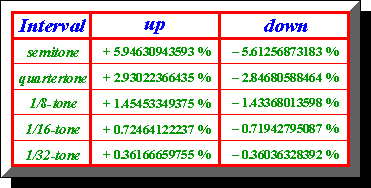 was found by mathematical interpolation from a good approximation for the middle of the Octave, and by subdividing each half-octave into three tones or six semitones, thus supplying the precise frequency ratios of our diatonic scale.41) Of course, –––––––––––––– 40) See Ed Metzler, Musical Theory (N. 30) p. 29 Note 41) The precision must be beyond what the human ear can hear and what the human voice or musical instruments can produce. Of the frequency ratios on the preceding page, all are less than 1/8-tone off the even-tempered standard, 5 less than 1/16-tone, and 2 less than 1/32-tone (cf. the above chart). Already the quartertone between two semitones is hardly appreciated (ibid. p. 24 Note [24]
all this was calculable 3 1/2 thousand years ago, for (7/10)2 = 49/100 and 50/100 = 1/2, so that the middle of the Octave is close to 7/10, and each half is easily divided into 3/10 and 3/15.42) § 14. It has been noted that Aristotle never mentions Pythagoras, but rather the Pythagoreans, meaning the Greek-speaking Jews and the cultural heritage of Israel, so that Hermippus of Smyrna (3rd century B. C. E.) is right in claiming that Pythagoras got all of his theories (Torah) from the Jews.43) Pythagorean “musical theory” in particular, derives from the Torah of Moses, and as “music” and the Muses take their name from Moses, being a Graeco-Roman deification of the Mosaical arts and sciences, Pythagoras lived in the street of the Muses or Moses called “museum”, the “Judengasse” or Jewish quarter.44) –––––––––––––– 42) This explains the relevance of the Mosaical matrixes on p. 18 supra, of tenths and fifteenths for music (ibid. p. 25 Note 40). 43) See Ed Metzler, Western Philosophy (N. 8) p. 6 Note 6; DISCOVERING MOSAISTICS (N. 1) p. 38 Note 16, and p. 149 Note 46; Wilhelm Capelle, Die Vorsokratiker (Stuttgart 1968) p. 99. 44) Cf. Jaap Mansfeld, Die Vorsokratiker (Stuttgart 1987) pp. 126–7 no. 6; and Ed Metzler, Musical Theory (N. 30) pp. 26–7. [25]
§ 15. How the “Metzler formula” derives from the measurements of the Tablets of the Law is demonstrated on the facing page.45) The manna [The printed graphics were replaced by their equivalents from this website] 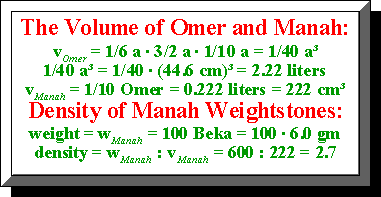 in the Omer proved identical with the volume of the Manah weightstone.46) Dividing the latter by the former yields the density of granite.47) –––––––––––––– 45) Cf. Note 25 supra. 46) See Ed Metzler, Musical Theory (N. 30) p. 17 Note 47) An alternative weightstone-density of 2.545 instead of the above 2.7, results from using the (Note which may be due to copying the Sinaitic granite Tablets of the Law or the uninscribed Broken Tablets (Manah-stones and Peka-cubes) in a material with a lesser density, such as the Jerusalem limestone, cf. DISCOVERING MOSAISTICS (N. 1) p. 195 Note 16. However, Shekels of 12.0 gm are also attested, see Abraham Eran, ‘Atiqot XV (Ashdod IV), 1982 p. 96 with further references. [26]
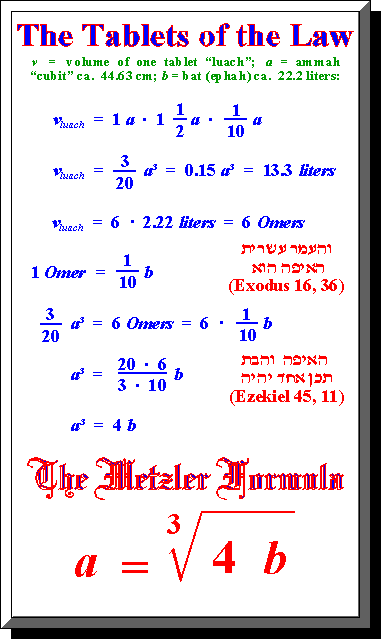 [27]
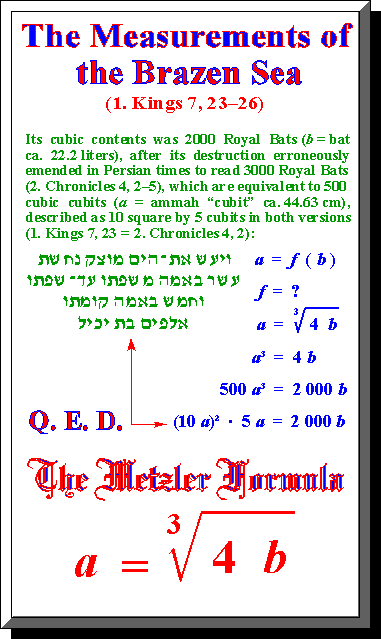 [28]
§ 16. In March of 1986, I applied the “Metzler formula” to the Brazen Sea, which the Bible describes in cubits and Bats.48) Its description [The printed graphics were replaced by their equivalents from this website] 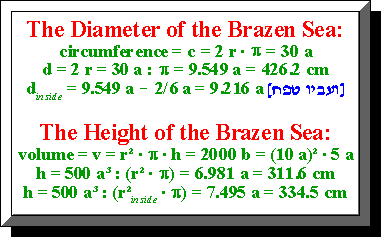 contains the metrological function expressed by my formula.49) Thus, I calculated the Brazen Sea for the first time since its destruction.50) –––––––––––––– 48) As to method, Ephraim Stern is right to state that only vessels marked Bat le-Melekh are to be used in determining its size (Encyclopaedia Judaica, Weights and Measures, vol. 16, 380–387). Similarly, I relied on weightstones marked Bet or Bet-Koph-‘Ayin, rather than marked Shin or Shin-Koph-Lamed, but they are not. 49) See DISCOVERING MOSAISTICS (N. 1) p. 24 Note 21, p. 149 Note 45, and p. 195 Notes 17 and 18. 50) Ibid. pp. 82–83 Note is 335 cm = 7.5 cubits instead of 312 cm = 7.0 cubits, if its thick- ness of twice 1 handbreadth (2/6 cubits) is taken into consideration. [29]
§ 17. The talmudic measurements of the Tablets of the Law are another application of the “Metzler formula”.51) The passage on the subject is [The printed graphics were replaced by their equivalents from this website] 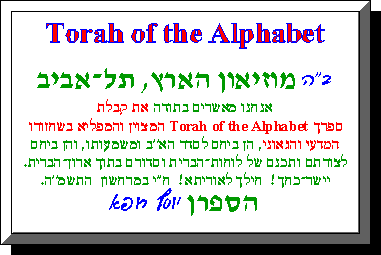 slightly distorted by an erroneous insertion, which occurred in the course of oral tradition, that can now be understood and corrected.52) –––––––––––––– 51) Cf. Ed Metzler, Musical Theory (N. 30) pp. 6–10. 52) A thickness of 3 handbreadths or 0.5 cubit is absurd, because it contradicts the notion of a tablet, sic Asher S. Kaufman, The Weight of the Tablets of the Covenant, – Where is Mt. Sinai? in Niv Hamidrashia vol. 22–23 (Tel-Aviv, May 1990/Iyar 5750) p. 29. However, he adds to the 6 by 3 handbreadths, and three fingerbreadths thick (ibid. p. 31). Hence both of his tablets are 1 square cubit or that their size “does not harmonize with the size of the Ark”, as Asher S. Kaufman agreed in a personal letter of January 18, 1995 in response to Ed Metzler, Musical Theory (N. 30) p. 9 Note [30]
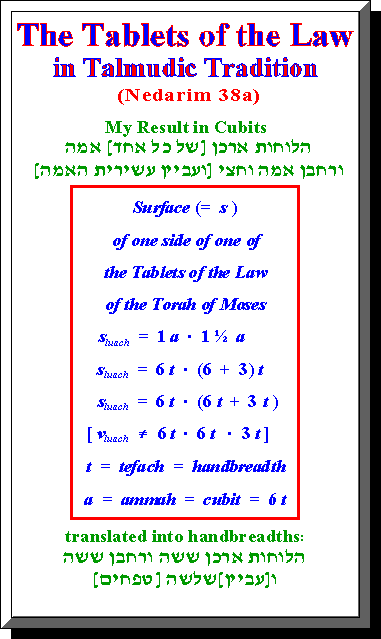 [31]
§ 18. The calculation below is based upon my discoveries concerning the Tablets of the Law of the Torah of Moses from the Sinai, and it is simply correct.53) Ever since it was published, and [The printed graphics were replaced by their equivalents from this website] 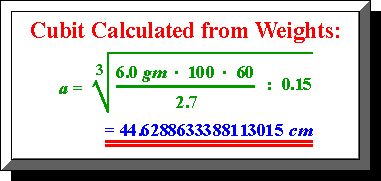 presented at the Jerusalem International Book Fair around Lag ba-Omer in May of 1985, I have been hoping for a breakthrough of my discoveries, but Israel sleeps, – wake up or rest in peace.54) –––––––––––––– 53) Cf. Ed Metzler, Musical Theory (N. 30) p. 16 Note There is no room for a double standard of cubits, a Solomonic cubit of 44.65 cm, and a Mosaical cubit of 42.8 cm, as Asher S. Kaufman (ibid.) contends. King Solomon’s Temple used the same Mosaical cubit of 44.63 cm as the Ark of the Covenant and the Tablets of the Law in its Holy of Holies, for which it was built. 54) See TORAH OF THE ALPHABET (N. 4) p. footnote; DISCOVERING MOSAISTICS (N. 1) p. 35 Note 9, p. 41 Note 23, and p. 49. The Halakhah on the Tablets of the Law must be distinguished from their Haggadah: Their weight is not designed to be carried by Moses alone, but always in the Ark by several men. [32] |
|
– at USA-$ 20.– per issue – Discovering the System of Mosaical Metrology  * Discovering the Three-Dimensional Structure of the Ten Commandments  * Discovering the Two-Dimensional Structure of the Alphabetical Order  * Discovering the Mosaical Roots of Kabbalah  * Discovering the Israelite Identity of the Pyramid Builders  * Conflict of Laws in the Israelite Dynasty of Egypt  * The Impact of Israel on Western Philosophy  * The Mosaical Roots of European Musical Theory  * On Mosaical Matrixes and the Metzler Formula  * inscription on the Tablets of the Law, and to prove the priority and centrality of Hebrew script in the world history of writing.” Bibliographical Quarterly of the and University Library in Jerusalem, Israel, VOL. 60, NO. 1–2 (1986) pp. 287–88, *3045–47. * ISBN 3-924448-12-4 |

© All rights
reserved - Alle Rechte vorbehalten
by Dr.
Ewald (Ed) Metzler-Moziani.